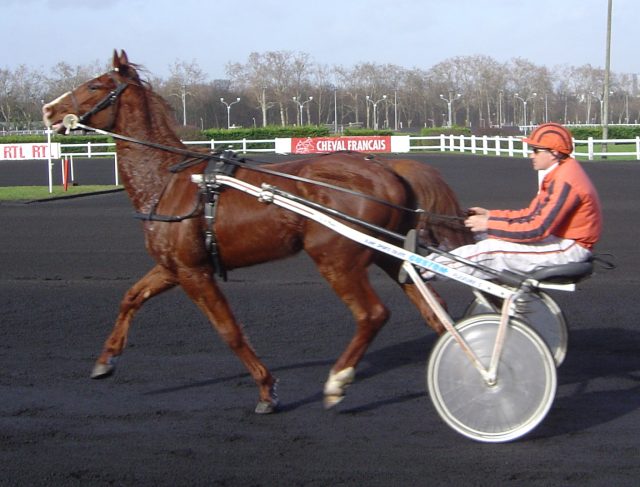Type the name of the breed you're looking for below
[wpdreams_ajaxsearchlite] Don't see the breed your're looking for? Click here and let us know!
French Trotter horse
| Country Of Origin | France |
| History and Background | Horses in France first began to be selectively bred for trotting races in the early to mid-1800s.The French Trotter developed primarily from Norman stock which was crossed with English Thoroughbred and half-bred hunter types, Norfolk Roadster, and some American Standardbred. The French Trotter is sometimes referred to as a Norman Trotter, due to the influence of the Old Norman horse on the breed's development. The early Trotters were rather heavier and coarser than they are now, bearing a greater resemblance to their Normandy ancestors, but infusions of Thoroughbred blood have greatly refined the early significant influences on the development of the breed were by the stallion Young Rattler, foaled in 1811, who was by the Thoroughbred, Rattler, out of a mare with a high percentage of Norfolk Roadster blood. Eventually five impressive Trotting lines were established and these were due to the stallions Conquerant, Lavater, Normand, Phaeton, and Fuchsia. Although there have been infusions of American Standardbred blood, the French Trotter has maintained the trotting gait ( diagonal two beat) from the trotting line of the Standardbred, as opposed to the pacing gait ( lateral two beat) an alternate line of the breed developed for speed. Breeding; After the continental trading blockade was raised, following the defeat of Napoleon Bonaparte at Waterloo in 1815, the market-wise Normandy breeders began to use their common but tough, all-purpose Norman stock as a foundation for breeding horses for general military use, both riding and light draught, and then, increasingly, to produce specialized horses of both types. Supported by the Administration of National Studs, they imported English Thoroughbreds and, just as importantly in the context of the trotting horse, English half-bred or hunter stallions, which were then unknown in France. They also imported the incomparable Norfolk Roadster the greatest trotter under saddle and in harness in the whole of Europe. Chief among the early imports was the half-bred Young Rattler (foaled 1811), by the Thoroughbred Rattler, out of a mare with Norfolk Roadster connections. He is often called "the French Messenger", as his influence on the French Trotter was close to that of Messenger, the foundation sire of the American Standardized Young Rattler, together with other half-bred stallions and the essential contribution made by the Roadster, the Norfolk Phenomenon, improved the Norman mares in terms of conformation, movement, and scope, and prepared them for subsequent crossing with English Thoroughbreds. Thirty years after Young Rattler, Thoroughbreds such as the Heir of Linne and Sir Quid Pigtail were making their mark. Ultimately, five important bloodlines became established: Conquerant and Normand, both sons of Young Rattler; Lavater, a horse by a Norfolk sire; and the half-breds Phaeton and Fuchsia. Fuchsia, foaled in 1883, sired 400 trotters, and over 100 of his sons were sires of winners. In due course Standardbred blood was added to give the Trotter more speed while maintaining the characteristic trotting gait. In 1937, to protect the qualities of the breed, which can now beat world-class harness-racers, the French Trotter Stud Book vas closed to non-French bred horses. Recently, however, it was partly opened to let in a few French/Standardbred crosses. |
| Use Today | Driving horse, Eventing horses, Sport horses |
| Height | 15.1 to 16.2 hands high (60-65 inches, 152-165 centimeters) |
| Colour | All solid colours. |
| Characteristics | The Trotters are bred for functional, not aesthetic purposes and there is quite some variation of physical characteristics within the breed. However, in general terms, they tend to have a slightly heavy and large head, which is plain, but not unattractive. The neck is of good proportional length, and is well set to shoulders which are becoming increasingly sloped. The withers are usually quite rounded, the back broad and strong, with extremely muscular quarters. The legs are very well conformed, being strong and muscular with good joints, hard, dense bone and very hard hooves. |
| Personality and Temperament | The French Trotter is a gentle and calm horse. It is very submissive and easy to train. It is most commonly used for breeding. Male trotters are used to mate with purebreds and are also fit for racing. The breeder usually assesses the trotters according to their corresponding category in racing. Because of its amazing strength and solid contour, the French Trotter was used in schools for horse riders. The breed shows exceptional gait, determination, discipline, intelligence and endurance. |
| Other Considerations | The French Trotter excels at both ridden and driven trotting races, and maintains a particularly balanced and level stride. |



